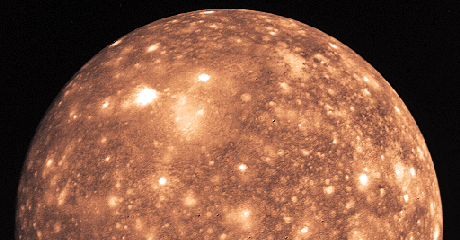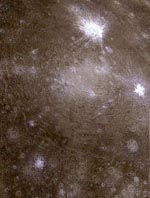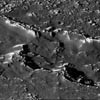
 |
orbit: 1,883,000 km from Jupiter
diameter: 4800 km
mass: 1.08e23 kg
Callisto
was a nymph, beloved of Zeus and hated by Hera.
Hera changed her into a bear and Zeus then placed her in
the sky as the constellation Ursa Major.
Discovered by Galileo and Marius in 1610.
Callisto is only slightly smaller than Mercury but only a third of its mass.
 Unlike Ganymede,
Callisto seems to have little internal structure;
however there are signs from recent Galileo data that the interior materials
have settled partially, with the percentage
of rock increasing toward the center.
Callisto is about 40% ice and 60% rock/iron.
Titan and Triton
are probably similar.
Unlike Ganymede,
Callisto seems to have little internal structure;
however there are signs from recent Galileo data that the interior materials
have settled partially, with the percentage
of rock increasing toward the center.
Callisto is about 40% ice and 60% rock/iron.
Titan and Triton
are probably similar.
Callisto's surface is covered entirely with craters. The surface is very old, like the highlands of the Moon and Mars. Callisto has the oldest, most cratered surface of any body yet observed in the solar system; having undergone little change other than the occasional impact for 4 billion years.
 The largest craters are
surrounded by a series of concentric rings which look like huge cracks
but which have been smoothed out by eons of slow movement of the ice.
The largest of these has been named Valhalla (right). Nearly 3000 km in
diameter, Valhalla is a dramatic example of a multi-ring basin,
the result of a massive impact. Other examples are
Callisto's Asgard (left), Mare Orientale
on the Moon and Caloris Basin on
Mercury.
The largest craters are
surrounded by a series of concentric rings which look like huge cracks
but which have been smoothed out by eons of slow movement of the ice.
The largest of these has been named Valhalla (right). Nearly 3000 km in
diameter, Valhalla is a dramatic example of a multi-ring basin,
the result of a massive impact. Other examples are
Callisto's Asgard (left), Mare Orientale
on the Moon and Caloris Basin on
Mercury.
 Like Ganymede, Callisto's ancient craters have collapsed.
They lack the high ring mountains, radial rays
and central depressions common to craters on the Moon
and Mercury.
Detailed images from Galileo (left)
show that, in
some areas at least, small craters have mostly been obliterated. This suggests that
some processes have been at work more recently, even if its just slumping.
Like Ganymede, Callisto's ancient craters have collapsed.
They lack the high ring mountains, radial rays
and central depressions common to craters on the Moon
and Mercury.
Detailed images from Galileo (left)
show that, in
some areas at least, small craters have mostly been obliterated. This suggests that
some processes have been at work more recently, even if its just slumping.
 Another interesting feature is Gipul Catena, a long series of impact
craters lined up in a straight line (right). This was
probably caused by an object that was tidally disrupted as it passed
close to Jupiter (much like Comet SL 9)
and then impacted on Callisto.
Another interesting feature is Gipul Catena, a long series of impact
craters lined up in a straight line (right). This was
probably caused by an object that was tidally disrupted as it passed
close to Jupiter (much like Comet SL 9)
and then impacted on Callisto.
Callisto has a very tenuous atmosphere composed of carbon dioxide.
Galileo has detected no evidence of a magnetic field.
Unlike Ganymede, with its complex terrains, there is little evidence of tectonic activity on Callisto. While Callisto is very similar in bulk properties to Ganymede, it apparently has a much simpler geologic history. The different geologic histories of the two has been an important problem for planetary scientists; (it may be related to the orbital and tidal evolution of Ganymede). "Simple" Callisto is a good reference for comparison with other more complex worlds and it may represent what the other Galilean moons were like early in their history.